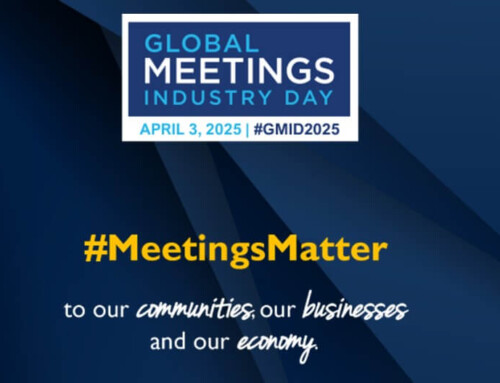This article includes historical information for context. While the core content remains valuable, some details reflect past events and may not be up to date. We regularly update our blog to keep you informed of current insights.
Spurred by social distance protocols, the coronavirus pandemic caused a major spike in the use of virtual meetings. While companies will likely continue to hold virtual meetings in the future, face-to-face meetings are still highly valuable. Virtual meetings can never replace in-person meetings entirely because they do not meet the all of the needs that in-person meetings do. In-person events will continue to be vital and essential when connecting with larger audiences, and creating experiences within the real-world.
Add hybrid meetings – which integrate virtual meeting elements with face-to-face sessions – to the mix and companies have a powerful way to grow attendance and connect with more people in the process. Live and on-demand options give attendees who cannot travel convenient, easy access to the event from anywhere in the world.
Types of Virtual Meetings
The term “virtual meetings” can apply to interactions made in several different ways. However, this isn’t a universal term that is applicable to all meetings utilizing technology to connect participants and meeting leaders/presenters.
- Telebridge/Conference Calls – A conference call can accommodate multiple people, from a one-on-one discussion to a department meeting. Set-up options include allowing the called party to speak or limiting their ability to listening.
- Web Conferencing – Taking virtual meetings a step beyond conference calls, web conferencing is an option to hold live meetings, presentations and employee training via the Internet. Participants can use a phone or computer’s microphone and speakers as audio during web conferencing.
- Video Conferencing – Using video conferencing, companies get a live, visual connection, complete with audio, between multiple people. Zoom is an example of a video conferencing platform that has experienced a massive surge in popularity due to the pandemic.
- 3D Environments – Commonly referred to as virtual reality, 3D interactive environments give the impression of being physically in an actual environment. The immersive experience facilitates interaction between participants that makes them feel like they are in the same room with each other. Participants can pan left or right, up or down, and even “walk” through the environment.
- Virtual Tradeshows – Take the elements of an in-person tradeshow, execute them online and the result is a virtual tradeshow. As the name implies, this type of meeting is hosted online and runs for a limited amount of time (just like a traditional tradeshow).
What is a Hybrid Meeting?
Put simply, a hybrid meeting is an event wherein people can choose to attend virtually or in-person. There are several compelling benefits delivered by hybrid meetings. In fact, a survey of hybrid event attendees revealed that 96 percent of them would not have attended or been unable to attend if the event if organizers did not offer virtual options. (4)
Far from cannibalizing meeting participation, hybrid events supercharge engagement among attendees. This model opens the ability to attend for those who cannot do so in-person or who may be restricted by budget but would find benefit in participating. Engagement will increase further when virtual attendees have the option to access content live or on-demand.
Rather than storing the webcast in an archived folder, businesses can also re-purpose it as an educational tool. Digital footage can easily be edited into multiple clips based on the topic and housed on the organization’s website or in the sales knowledgebase toolkit. Better yet, the business can leverage the footage as gated content where website visitors must provide their contact information in order to access it. This can help build lead lists and provide valuable sales tools.
Hybrid events do, however, have drawbacks. One of the most significant drawbacks is how challenging they are to plan. Since hybrid meetings incorporate elements of both in-person and virtual events, not every meeting planner can easily navigate the logistical needs of both.
Planning hybrid meetings are extremely difficult from the technical standpoint, as well. Virtual elements are completely dependent on technology working as it should. Not only does safeguarding against technical failures require investing a significant amount of time and energy, but it requires selecting the right technology partners, set up and contingency plans.
Additionally, in-person planning is still part of the hybrid meeting process. Venue selection, vendor partners, cost containment strategies, contract negotiation and review as well as on-site staffing requirements are other elements that must be factored into the equation.
Face-to-Face Meetings Reign Supreme
Examples of face-to-face meetings include high stakes board meetings and senior leadership meetings, offsite training and offsite product announcements or launches. Traditionally, these meetings have been conducted in-person, and for good reason.
- 84 percent of executives agree that team productivity is at its best when people meet face-to face. (1)
- More than 25 percent of business travelers expect to attend off-site business meetings and conferences in the next six months. (2)
- 83 percent of Americans currently forced to work from home indicate they miss attending in-person meetings and conventions. (3)
- 78 percent of people state they plan to attend as many or more in-person meetings when the threat of COVID-19 passes and it is safe to do so. (3)
In-Person Meetings Are Vital to Business
Why do people prefer in-person meetings over virtual meetings?
- They foster a sense of anticipation that clicking on a link cannot replicate.
- They offer a new experience especially if it’s to a new destination.
- First impressions are important in business and can differ greatly between in-person and virtual interactions.
- There are no interruptions nor multi-tasking because everyone is in the same room.
- The small talk that takes place in person can help build relationships and make connections.
- Brainstorming and collaborating is much easier to facilitate using a white board in a room that pulsates with the energy of attendees.
- Engagement levels are higher because it is nearly impossible to avoid other people when they are physically present.
- Natural conversation sparks opportunities that are not provided in a virtual setting.
- The tone of voice and body language of attendees encourages participants to express their views and ideas without fear of being misunderstood or embarrassed.
- Physical cues are better interpreted in person, minimizing misunderstandings.
- Meeting face-to-face supports bonding, fosters camaraderie and sets the stage for relaxing, enjoying the experience and getting to know fellow attendees.
- The lower tech aspect of in-person meetings decreases the risk of issues such as technology freezes, bad connections, malfunctioning audio, cable cross-talk or technology feedback, etc.
- Attendees feel like their work is valued, their input is appreciated and they are truly part of the team.
- Participants have an opportunity to share their stories, experiences and ideas with their colleagues.
- Breakout groups, networking opportunities, real-world connections can occur faster, are more effective and lead to breakthrough moments.
When In-Person Meetings Are Essential
In some cases, virtual meetings can replace face-to-face meetings and still deliver value. Leadership can use different factors to determine whether meetings should be held in-person or virtually.
Face-to-face meetings are the better option if:
- The meeting would be more productive in person. This may be the case if the team has a history of conflict, struggles to communicate or there is an objective that needs to be achieved quickly
- The topic at hand imposes a budget and a timeline, rendering it important enough to make allowances for planning, travel and entertainment
- The attention, participation and engagement of key attendees is critical
- Establishing trust and building relationships and teams is one of the goals
- Leadership must deliver bad news or sensitive information such as plans to shut down a division or a merger/acquisition that requires workforce reductions
- An awards ceremony is to be held for stakeholder appreciation such as for top performers, biggest change-makers or innovators, etc. Recognition is better delivered in a face-to-face environment.
- It is to celebrate a team’s success especially when accomplishments were made in spite of high stakes, difficult challenges, and/or there was a high level of collaboration or critical thinking required.
Virtual meetings may be the business trend of the moment, and likely will continue to grow in popularity as remote work increases. However, there are certain needs that they simply cannot meet. In-person meetings remain the gold standard for organizations of all types and sizes, especially when communication is critical, engagement is vital, and collaboration is a necessity.
Uncertain times call for creative thinking. Contact Gavel International to be inspired by solutions that connect and engage your people.
____________________________
SOURCES:
1 https://www.meetingsmeanbusiness.com/sites/default/files/MMB%20Business%20Leaders%20Survey%20Key%20Findings.pdf
2 https://fileshare.mmgyglobal.com/index.php/s/M4d5smNSa3OOyfB/download
3 https://www.meetingsmeanbusiness.com/sites/default/files/MMB%20COVID-19%20Survey%20Results_April%2010.pdf
4 https://www.youtube.com/watch?v=5QGWSOnqBEA
This article was last updated on April 25, 2025
- Memorable Meetings in Abundant Sunshine and the Natural Beauty of Phoenix - March 24, 2025
- Incentive Trailblazing with John George in Banff, Canada - December 4, 2023
- Nature’s Playground: Big Sky and Bozeman, MT - September 26, 2022






